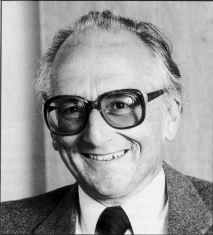 Chuck Peddle
Chuck Peddle Chuck Peddle
Chuck PeddleChuck Peddle got the idea of developing a personal computer. It should be a closed system that can immediately be used after plugging it to the power outlet. The result was the PET. Almost at the same time the Apple II was introduced. PET's features were built-in monitor, integrated cassette device and the well-known BASIC interpreter from Microsoft. The PET has survived many modifications and is still popular, thanks to the typewriter keyboard introduced in later models.
He is one generation older than the miracle children among computer constructors, Stephen Wozniak and Steve Jobs. In 1973, Chuck Peddle went to Motorola to among others co-operate in developing the 6800 microprocessor.
The 6800, one of the first microprocessors on the market, was correspondingly expensive with its price of 200 dollars. Chuck Peddle thought that this price would inhibit the processor from conquering the market. He left Motorola and had a fresh start at MOS Technology.
What he developed in this relatively small company, should soon become the most successful microprocessor of the first microcomputer decade -- the 6502 MPU. Nobody could anticipate that it was the basis of a whole industry that started a social revolution.
One person who detected the worldwide effects of microprocessors and especially the 6502 from MOS Technology was Jack Tramial, the ex-president of Commodore. Until then Commodore's turnovers had been very modest.
It is not hard to understand that Tramiel, the main client of 4-function-chips for pocket calculators by MOS Technology, bought the company the other day, although Commodore was in financial troubles itself. But for Tramiel, the most important part of the deal was among the 6502 the developing engineer Chuck Peddle.
Chuck Peddle had certainly also made an impression with his concept of a personal computer. Similar ideas were brought out independent of Peddle by the Apple founders Wozniak and Jobs. Chuck Peddle was so sure of his idea that he allied with Bill Gates, the founder of Microsoft and father of the popular BASIC interpreter, to buy up Apple. This took place almost at the same time when Commodore bought MOS Technology. Wozniak and Jobs wanted back then 150,000 dollars for Apple, but Peddle and Gates could only raise two thirds of the required funds.
Thus Chuck Peddle stayed at Commodore and in 1977 took over the development of the PET (Personal Electronic Transactor). At the same time Wozniak and Jobs were building the Apple II. The PET differed from it by its built-in monitor, integrated cassette device as well as by a keyboard, whose quality could be better compared with a pocket calculator than with a typewriter. In spite of this disadvantage, the first lot of 1000 PETs were rapidly sold at about 1600 dollars a piece. The first generation of microcomputers was born that was specially developed for private home use.
Three years later Chuck Peddle developed a new talent -- the one of a company president. Together with Chris Fish, a former financer of Commodore, he founded Sirius Systems Technology as daughter enterprise of the Walter Kidde Corporation.
The development in the area of personal computers was concentrated on the 16-bit chips at that time, like the Intel 8088. Also IBM was working on a PC, but Sirius brought the Sirius I some weeks earlier to the market. The Sirius I was the first inexpensive microcomputer of the 16-bit generation that was produced in big quantities and was widely noticed.
The Sirius I could be used very conveniently, thanks to its detached keyboard and flicker-free high resolution graphics monitor. The Sirius I set an until then unknown standard for microcomputer office systems.